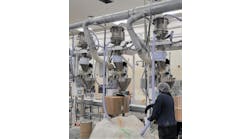The phrase “a little goes a long way” often comes up when talking about additives to prevent scaling or fouling in chemical processes. However, another school of thought believes that more is better. After all, if a little reduces the scaling, then more could eliminate it. One example is the use of steam to decrease foaming in a crystallizer. More increases the evaporative load and productivity of the device but a little prevents carryover of fine droplets and fouling.
The more-is-better philosophy comes into play in equipment design as well. Not that long ago, engineers commonly added a significant safety factor when sizing equipment to allow for unknowns in the design. Many project managers have told me that every dollar put into the project yields a dollar of profit. An engineering director of a major company said that every piece of equipment he designed as a junior engineer could produce at a rate at least twice that of the original design. However, he added he would fire any engineer doing that now. In today’s economy, bigger is not better if you want to keep your job!
So, how do you get the best productivity with smaller devices? Let’s look at a couple of examples.
Boosting production in a fluid bed dryer. A company wanted to triple output but didn’t have enough space to accommodate a bigger dryer along with all the other equipment necessary for the expansion. It looked like the firm would need a new building. This product was unique because the finished material could contain as much as 5% moisture — the more water in the material, the greater the profit margin. To avoid exceeding the 5% specification, most production was in the ≤2% moisture range. In addition, the dryer had several operating problems that often over-dried the product:
• Its filter bags plugged.
• These bags were located inside the dryer body and fine particles were being recirculated back to the bed, which caused the bed to collapse due to the excessive entrainment load.
• Not only did that over-dry these particles but the filter got overloaded.
• The amount of fluidization air was much more than required to suspend the solids. It had been increased to reduce bed collapse but just made the situation worse.
My first action was to get a drying curve and model the dryer. Samples taken from the dryer showed that the fine particles were instantly dried. Our initial step was modifying the filter to discharge the fines directly to the outlet of the dryer because they were virtually dry enough to meet the moisture specification. The dryer model suggested that raising inlet gas temperature, expanding the bed area by 20% and doubling the bed depth would increase production very close to the goal. The last step was adding an infrared moisture analyzer to verify moisture doesn’t exceed 5%. Blending the dryer output and the dry fine particles would ensure meeting product quality goals. Later, the plant installed a dehumidifier to boost production during humid weather. The savings were enormous because the modifications fit inside the existing building.
Dealing with a conical dryer that was a process bottleneck. The plant had available another conical dryer that was twice the size of the original one. So, manufacturing shifted production to that unit — with disappointing results. The larger dryer yielded a lumpy product that varied in moisture content and required more cleaning at the end of a batch. Reaching the desired moisture content necessitated an increase in batch time; the extra cleaning requirements meant the net production rate wasn’t any higher.
A drying test showed that the critical moisture content was very low, so only heat transfer should limit drying. However, the gas in the dryer was saturated with moisture. The overall heat transfer coefficient was very low, indicating not enough mass transfer of the moisture.
The original conical dryer had a bottom nozzle that was used for cleaning. Feeding a small amount of gas through that nozzle to carry off the moisture decreased drying time by a factor of three. The dryer had more than enough heating capacity but the moisture couldn’t get out of the dryer without the extra gas, giving us yet another example of a little goes a long way and bigger is not always better.



